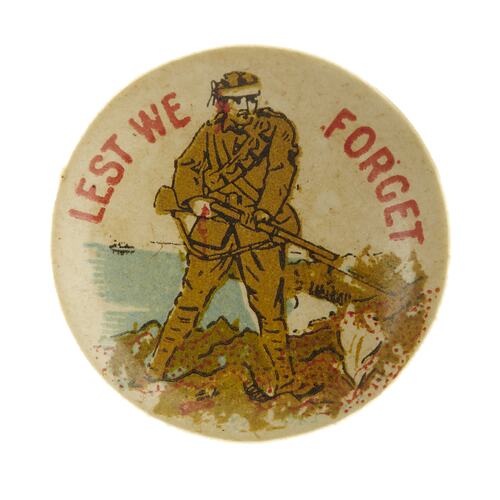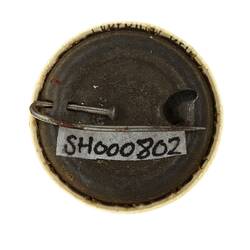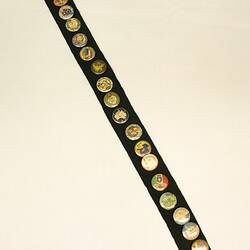Summary
Alternative Name(s): Button, Pin
Circular pressed tin fundraising badge - 'Lest We Forget'. The central image is of a soldier advancing with rifle in a rocky, ocean cliff landscape that is dotted with red spots possibly depicting poppies. (The location depicted may be the Gallipoli Peninsula.) The soldier's head is bandaged and spots of red indicate that the soldier has sustained wounds to the head and hand.
One of 24 fundraising badges attached to a black velvet ribbon. Purchased and collected by the donor's great-grandmother, Mrs Lillie Mary Holinger, in Melbourne (probably Canterbury).
Badges were worn or displayed on ribbons during and after World War I, commemorating involvement in the war effort and expressing patriotism. They were generally made to raise funds for particular causes, including comforts and medical aid for those serving overseas; assisting widows and children of deceased soldiers; and assisting with the purchase of aids and treatment for soldiers who returned with disabilities.
Pezikin and Andersen (2017, p.15) indicate that the badge was one of those issued for the August 1915 'button day', held on what was then Australia Day, Friday 30 July. It raised funds for the Australian Wounded Soldiers Fund. Over 200,000 buttons were made. The St Arnaud Mercury reported on 7 August (p.2) that 'Button Day was observed locally yesterday, when the ladies made a systematic canvass of the town... The supply was not anything like equal to the demand. The emblem displayed a wounded solder in uniform and holding a rifle in his hands, and on the upper portion of the button were the significant words, "Lest we Forget." The seller wore a distinguished red cross badge on the left arm, and a large card on the collecting boxes exhibited a red cross and the words "For our own wounded; we can all help; give cheerfully."'
Physical Description
Circular pressed tin badge with the words 'Lest We Forget' written around the top of the badge in red capitalised text. The central image is of a soldier advancing with rifle in a rocky, ocean cliff landscape that is dotted with red spots possibly depicting poppies. The soldier's head is bandaged and spots of red indicate that the soldier has sustained wounds to the head and hand. The back of the badge is a dull tin with minor rust. A bent nail has been utilised as the pin and is attached through a hole in the back of the badge.
More Information
-
Collecting Areas
-
Acquisition Information
Donation from Mrs Bronwyn Mitchell, 15 Feb 1994
-
Date Made
-
Inscriptions
Text: 'LEST WE FORGET'
-
Classification
-
Category
-
Discipline
-
Type of item
-
Overall Dimensions
2.3 cm (Width)
-
References
'The Recessional,' Australian War Memorial, [Link 1] 'The Ode of Remembrance,' Fifth Battalion The Royal Australian Regiment Official Website (archived), [Link 2]://5rar.asn.au/ode.htm. BUTTON DAY. (1915, August 7). St Arnaud Mercury (Vic. : 1914 - 1918), p. 2. Retrieved February 20, 2019, from [Link 3]
[Book] Pezikian, Nick & Andersen, David. 2017. Commonwealth Button Fund: WWI Patriotic & Fundraising Badges., 2017, 15 Pages
-
Keywords




